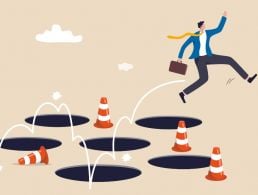Hays’ James Milligan looks at the wider workplace landscape and considers what the next set of trends and changes will be.
The future of work is a constantly changing concept. It is both here and in the future because the trends that were once futuristic are now being lived – or at least a version of them are.
Many of the trends considered ‘future-of-work’ trends have already started to bleed into our everyday lives. But we are still only at the earliest stages of many of them, and an ever-changing market can often lead to forks in the road for these trends.
With all of this in mind, SiliconRepublic.com spoke to Hays’ James Milligan about what the current landscape looks like, how it has changed in the last year and what it could mean for the medium and long-term.
The revolving office door
While a major future of work trend for many years was around the notion of remote working, Covid-19 pushed that into the present day. But more than three years since the pandemic began, what is the new trend like in this area?
Speaking to SiliconRepublic.com, Milligan said there’s an undeniable return-to-offices trend happening at the moment that is becoming increasingly mandated over time.
“I think the jury’s still out on terms of where that’s going to end up because we’re in a market that’s probably slightly more favourable for the employer at the moment than it was 12 or 18 months ago,” he said. “I think it has been an interesting trend, one I didn’t anticipate.”
Office revamp
While there’s still a question as to where each workplace will end up when it comes to their hybrid and remote policies, how the office building is actually used has certainly seen a big change and that’s a major trend that’s set to continue.
“There are less banks of desks,” said Milligan. “There are a lot more open spaces, collaborative spaces. I think that’s a trend that’s here to stay.” He added that office design on the whole has evolved significantly over the last number of years, so while the amount of time we spend in the office may vary, how that office looks will be much more built to focus on collaboration and learning rather than in silos.
The role of generative AI
Milligan said the biggest workplace disrupter in recent months has been generative AI and virtual assistants such as ChatGPT, and it’s the presence of these tools that will majorly influence the future of work.
“Let’s take an example. You run a meeting, somebody has to capture all the actions and minutes. Now, you can plug something into that platform that will summarise and do all of that work for you, and it means you can focus more on the discussion of the content,” said Milligan.
“Hopefully, it will make life easier for employees and allow people to focus on tasks which are higher value [and involve] more creative thinking rather than some of the more administrative tasks.”
Mindful use of technology
While the workplace is undoubtedly becoming more digitally focused, Milligan noted that there is now a strong recognition around the benefit of utilising technology versus the risks it poses to mental health and wellbeing.
“Organisations are now [trying to] understand how you get that balance right because it’s a benefit to no one for someone to be burned out behind the screen,” he said. “So, a lot more of the dialogue is around ‘how do we get that balance right?’”
He said a key trend that goes hand in hand with this need is more openness and honesty within the workplace about how employees are feeling rather than a “superficiality” that might come with simply informing staff of good practices and considering it a box checked.
A change in HR tech
During our last Future of Work week, we discussed the surge in HR tech investment. A whole host of European start-ups were riding the HR tech train, and there were plenty of tools for workplaces to capitalise on.
But as that surge levels off, the current trend seems to show that there is less talent movement and less hiring, leading to a slow down in the need for so much HR tech. Similar to the right-sizing that came with Big Tech’s layoffs, Milligan said that “adjustments have taken place within the market”.
“It’s probably a normalised market at this moment in time rather than the hypergrowth market that existed,” he said. However, he did remain optimistic about the HR tech sector.
“I do think that in the medium term, it’s a sector that there’s lots of opportunity … I just think because of this adjustment that’s taking place, the volumes at every stage of a process in recruitment or all of the other areas that HR venture has to cover is probably less now.”
10 things you need to know direct to your inbox every weekday. Sign up for the Daily Brief, Silicon Republic’s digest of essential sci-tech news.









